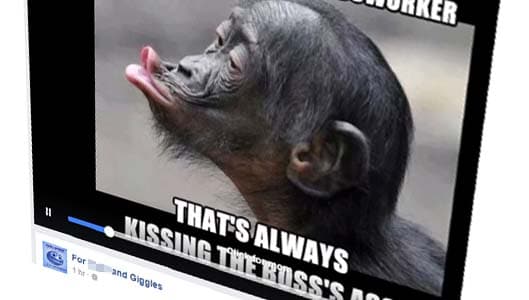Why are there so many video memes of still images on Facebook?
In 2017, the latest trend you may have noticed happening on your Facebook newsfeed is video memes.
Only they’re not videos, they are static, still images that have been turned into a video, usually ranging from around 15 seconds to 2 minutes where – upon being played – nothing actually happens. It’s just a still image.
What’s the point?
As is so common on Facebook, it all boils down to getting as many people to see your content as possible.
It is no secret that Facebook – over the last few years – has been pushing video content to the forefront of their priorities. The social networking giant has released several video-centric features including Live Video where any user can stream live video on the site from wherever they are. And – more importantly – Facebook has also made little secret that they are willing to reward pages that regularly publish video content to their pages.
While the official line from Facebook is that video content doesn’t automatically mean more reach when compared to other types of content, metric tests suggest otherwise. Videos not only circulate more prolifically across the site, they are also more likely to attract engagement, including comments and reactions.
Sponsored Content. Continued below...
Take this post from For Sh**s and Giggles Facebook page that posted a static image that accumulated nearly 10 million views at the time of writing, one their most viewed posts.
One possible reason for this increased engagement is that users are more likely to hit play on a video, without necessarily knowing the video is just a static image. Nevertheless, that play still counts as a form of engagement, and hitting play is likely to provide the video with increased reach.
Additionally, video content is likely to appear on more newsfeeds simply because Facebook users are watching more video content than ever before. Facebook try and personalise a user’s newsfeed, meaning the more video content a user watches, the higher priority that content is given in the newsfeed in the future. As more users watch video, it becomes clear why many publishers are preferring to morph their static memes in to video format.
All of this means that image memes are being converted to video simply because it will result in a larger audience. Of course if publishers continue to “game” the system like this for too long, it is likely Facebook will begin penalising video content with no video or animation and give priority to genuine video content, though this is currently mere speculation.
Continued below...
Thanks for reading, we hope this article helped, but before you leave us for greener pastures, please help us out.
We're hoping to be totally ad-free by 2025 - after all, no one likes online adverts, and all they do is get in the way and slow everything down. But of course we still have fees and costs to pay, so please, please consider becoming a Facebook supporter! It costs only 0.99p (~$1.30) a month (you can stop at any time) and ensures we can still keep posting Cybersecurity themed content to help keep our communities safe and scam-free. You can subscribe here
Remember, we're active on social media - so follow us on Facebook, Bluesky, Instagram and X
